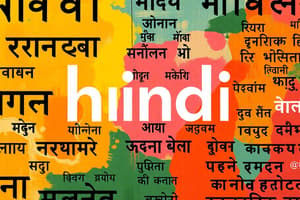Podcast
Questions and Answers
What is the script used to write Hindi?
What is the script used to write Hindi?
- Arabic
- Cyrillic
- Latin
- Devanagari (correct)
Which of the following languages did Hindi evolve from?
Which of the following languages did Hindi evolve from?
- Sanskrit (correct)
- Latin
- Chinese
- French
What type of word order does Hindi predominantly use?
What type of word order does Hindi predominantly use?
- Subject-Verb-Object (SVO)
- Object-Subject-Verb (OSV)
- Verb-Subject-Object (VSO)
- Subject-Object-Verb (SOV) (correct)
Which of the following regions has a significant Hindi-speaking community?
Which of the following regions has a significant Hindi-speaking community?
What is a notable challenge faced by learners of Hindi due to its regional varieties?
What is a notable challenge faced by learners of Hindi due to its regional varieties?
Flashcards are hidden until you start studying
Study Notes
Overview of Hindi
- Language Family: Indo-Aryan, part of the larger Indo-European family.
- Official Status: One of the 22 scheduled languages of India; official language of the Indian government.
- Script: Written in Devanagari script.
Historical Background
- Origins: Evolved from Sanskrit through Prakrit and Apabhramsha languages.
- Development: Influenced by Arabic, Persian, and English due to historical interactions.
Linguistic Features
- Phonetics: Rich in vowels and consonants; includes retroflex sounds.
- Grammar:
- Inflected language with gender (masculine and feminine).
- Uses postpositions rather than prepositions.
- Subject-Object-Verb (SOV) word order.
Vocabulary
- Sources: Derived from Sanskrit, with significant borrowings from Persian, Arabic, and English.
- Dialects: Numerous dialects exist, including Bhojpuri, Awadhi, and Haryanvi.
Cultural Significance
- Literature: Home to a rich literary tradition, including poetry, novels, and plays.
- Cinema: Widely used in Bollywood films, contributing to cultural dissemination.
Usage
- Speakers: Spoken by over 500 million people globally, primarily in India and Nepal.
- Global Presence: Significant communities in the United States, Canada, and the UK.
Learning Resources
- Textbooks and Courses: Numerous resources available for beginners to advanced learners.
- Online Platforms: Language apps and websites offering interactive lessons and practice.
Challenges
- Dialects and Variations: Regional dialects can vary significantly, affecting comprehension.
- Standardization: Differences in spoken and written forms can present learning challenges.
Overview of Hindi
- Hindi belongs to the Indo-Aryan subgroup of the Indo-European language family.
- It is one of the 22 scheduled languages of India and serves as the official language of the Indian government.
- Hindi is written in the Devanagari script, which is an abugida consisting of 11 vowels and 33 consonants.
Historical Background
- The language evolved from Sanskrit, passing through stages of Prakrit and Apabhramsha.
- Historical interactions have led to substantial influence from Arabic, Persian, and English on the development of Hindi.
Linguistic Features
- Hindi has a rich inventory of vowels and consonants, including unique retroflex sounds not found in English.
- It is an inflected language that classifies nouns and pronouns by gender (masculine and feminine).
- Utilizes postpositions (placed after words) rather than prepositions, typical for many Indo-Aryan languages.
- The standard word order is Subject-Object-Verb (SOV), which differs from the more common Subject-Verb-Object (SVO) in English.
Vocabulary
- A significant portion of the vocabulary derives from Sanskrit, enriched by borrowings from Persian, Arabic, and English.
- Hindi encompasses a variety of dialects, including Bhojpuri, Awadhi, and Haryanvi, each with distinct characteristics.
Cultural Significance
- Hindi boasts a vibrant literary tradition with renowned works in poetry, novels, and theatrical plays.
- It plays a crucial role in Bollywood cinema, facilitating the spread of culture and language both in India and abroad.
Usage
- More than 500 million people speak Hindi worldwide, with a primary concentration in India and Nepal.
- Prominent diaspora communities of Hindi speakers exist in countries such as the United States, Canada, and the UK.
Learning Resources
- A plethora of textbooks and courses cater to learners at various proficiency levels, from beginners to advanced speakers.
- Online platforms, including language learning apps and websites, provide interactive lessons and practice opportunities to enhance language skills.
Challenges
- The presence of numerous regional dialects can lead to significant variations that may complicate understanding.
- Differences between spoken forms and standardized written Hindi can pose challenges for learners seeking proficiency.
Studying That Suits You
Use AI to generate personalized quizzes and flashcards to suit your learning preferences.



